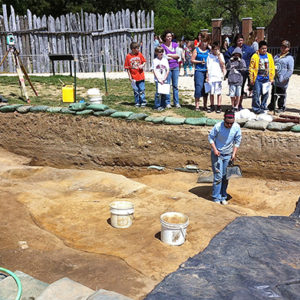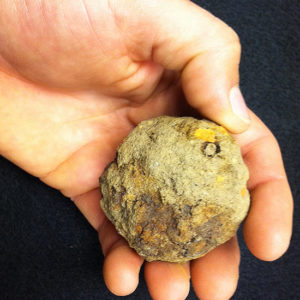Exciting artifacts began to come out of the ground within days after the first shovels of dirt opened the 19th archaeological season at Historic Jamestowne.
The ground has yielded a brass Nuremberg jetton used for making mathematical calculations, iron shot for a piece of artillery known as a falconet, and a piece of Dutch delftware tile from the 1640s depicting the leg of a soldier figure. The most spectacular find so far is the lower leaf of an ivory pocket sundial known as a diptych dial. Made in Nuremberg, Germany, the dial bears the name of Hans Miller, who is known to have been crafting these objects in the early 17th century.
And Jamestown Rediscovery archaeologists have found evidence of what appears to be filled-in cellars at least 25 feet long from the early James Fort period (1607-1610).
This feature is in an area west of the brick church tower and north of the recently rediscovered 1608 church, the first substantial church built at Jamestown. In 2001 archaeologists were digging down into the earthworks that remained of a Civil War fort and found evidence of the feature. But other investigations had priority so the feature was sealed for later. In 2010 excavations north of this unexplored area uncovered a corner of the archaeological feature.
It aligns with James Fort’s first well, which sits just 10 feet away and at the same angle. Ralph Hamor, secretary to the colony from 1611 to 1614, wrote that a substantial storehouse in that area of the fort was 120 feet long by 40 feet wide, so the archaeologists will be investigating whether this feature is part of that structure.
The Jamestown Rediscovery archaeologists will also soon return to the bomb shelter of the Civil War-era Fort Pocahontas. The shelter intersects the northern palisade of James Fort. Last summer archaeologists found the floor of the front room to the shelter (on its southern end), and plans are to now work northward on the feature, focusing on the bulkhead entrance on its west side.
related images
- Jamestown Rediscovery archaeologist M.A. Richardson stands to the side of what appears to be a cellar feature from the early James Fort period
- This fragment of Dutch deltware tile from the 1640s was found in the area just west of the church tower that archaeologists opened in April
- This iron shot was for a piece of artillery known as a falconet — a light, cheap cannon that fired small yet lethal shot








